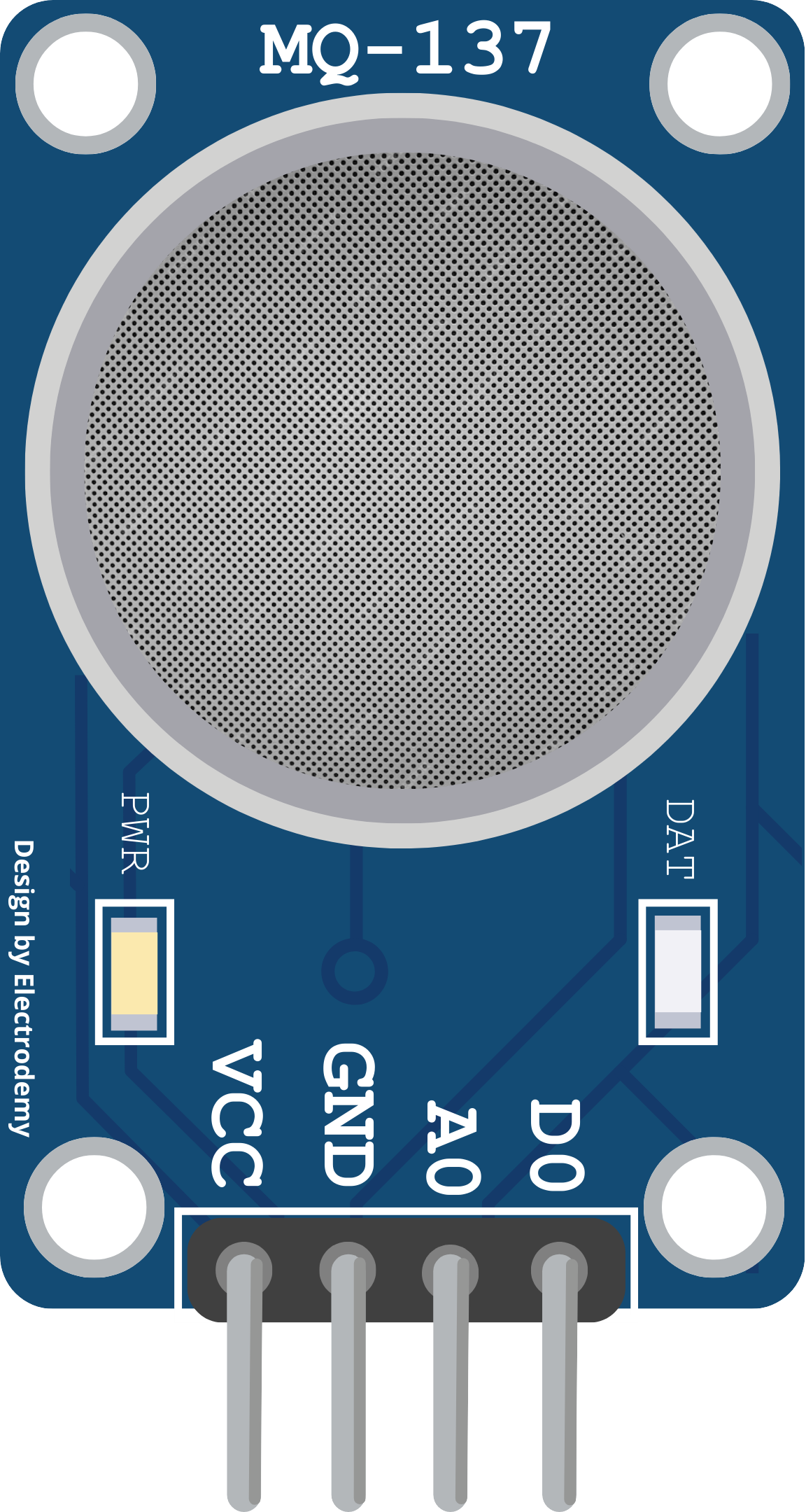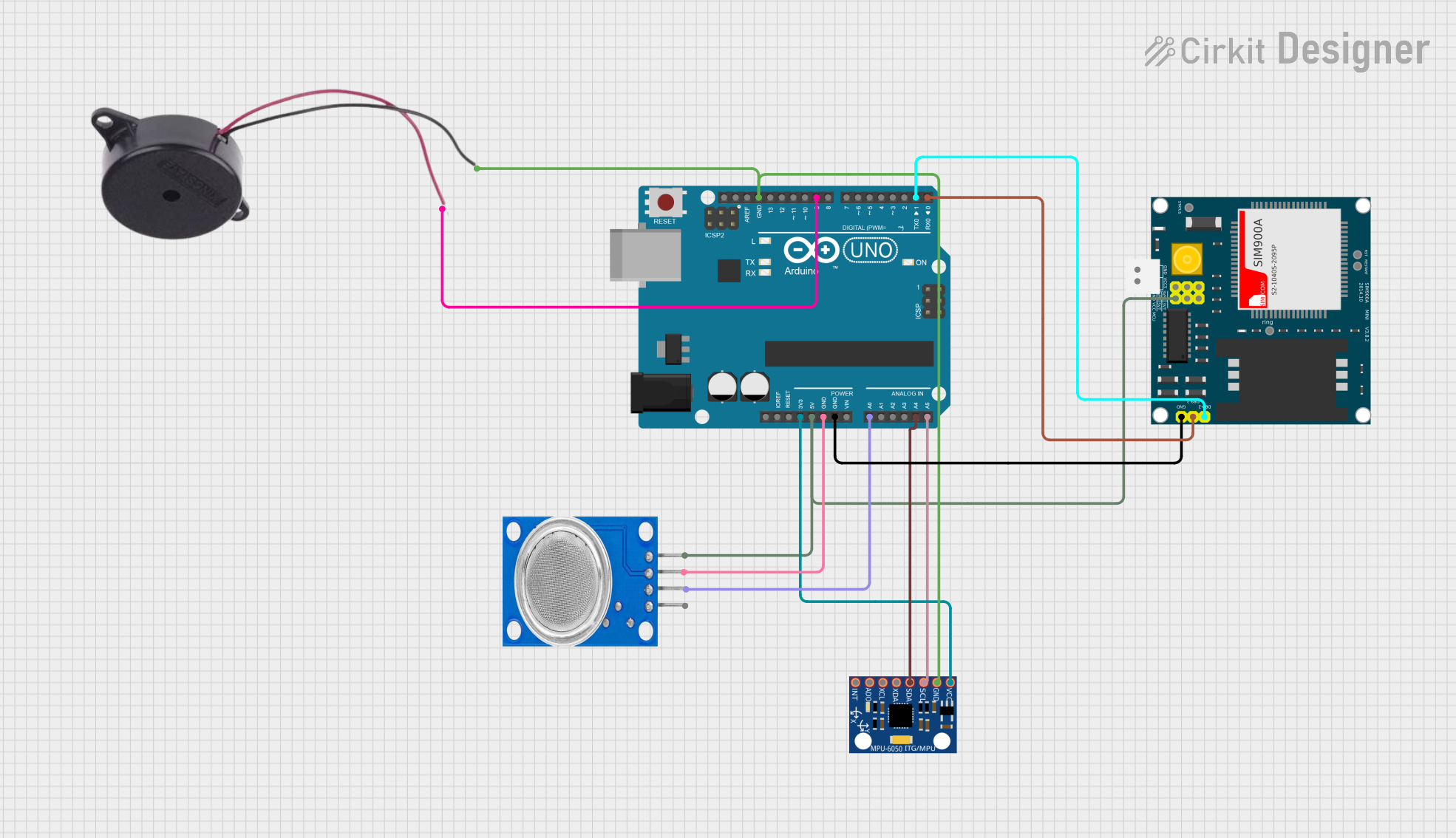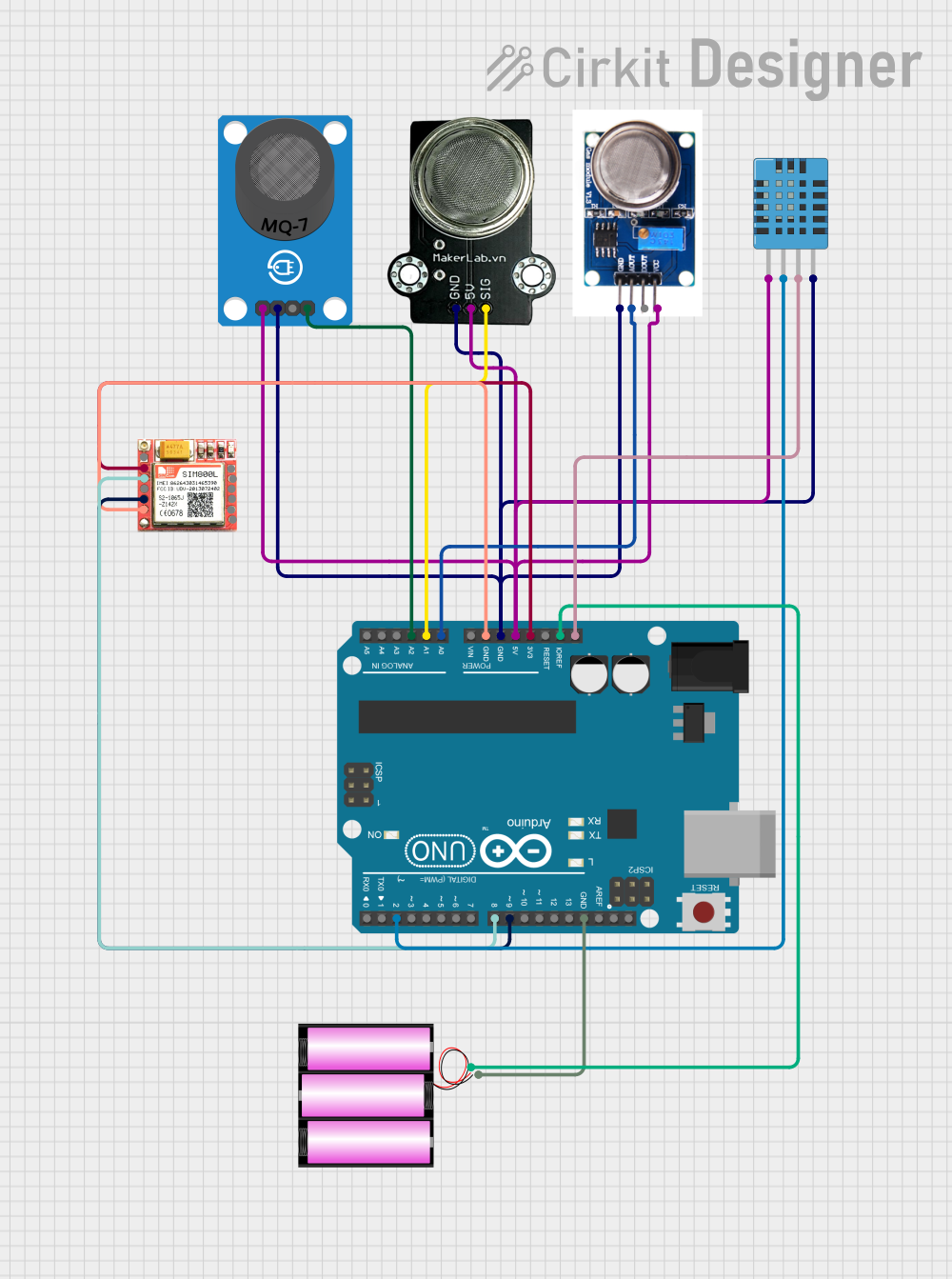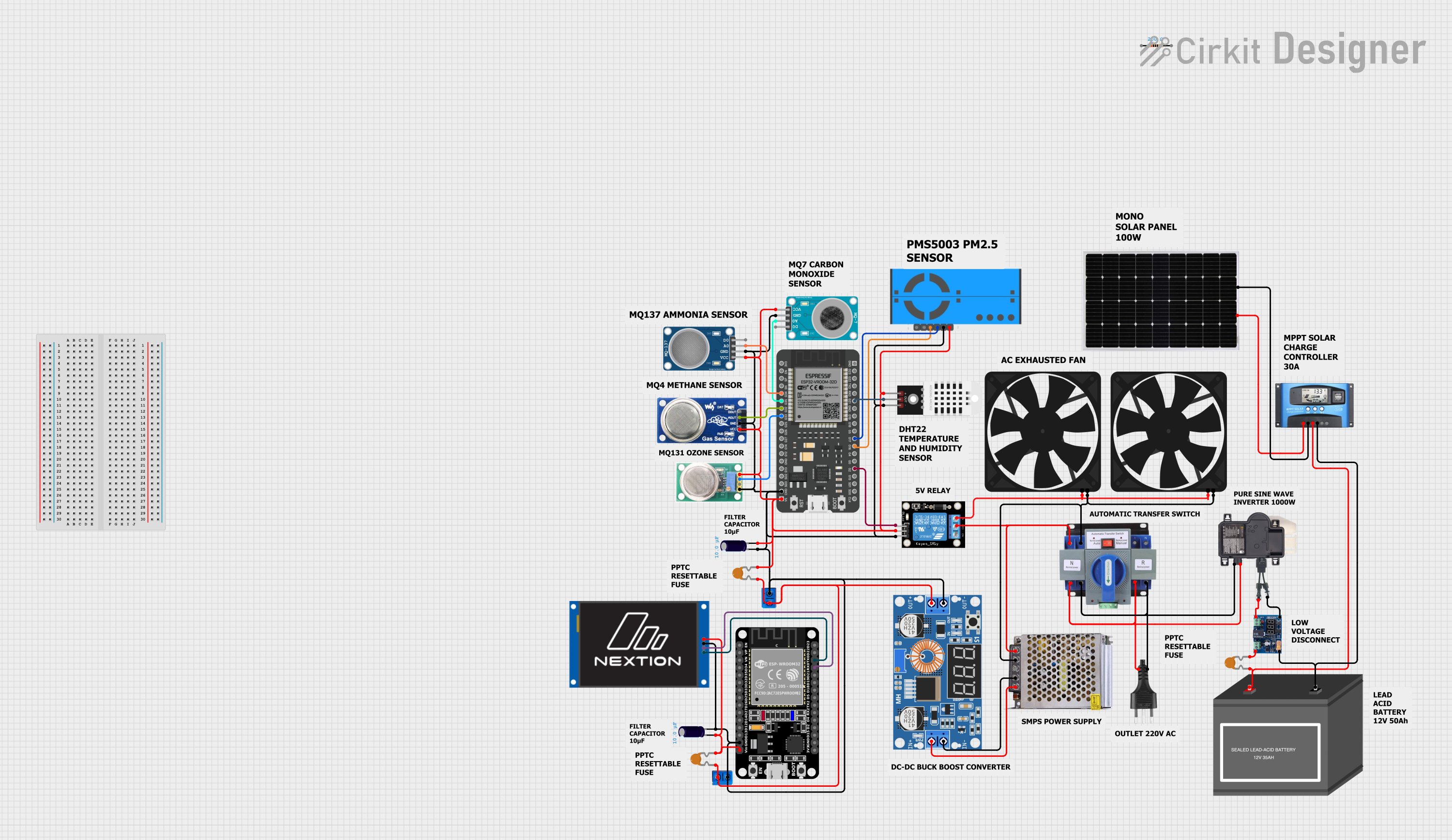
How to Use MQ137: Examples, Pinouts, and Specs

 Design with MQ137 in Cirkit Designer
Design with MQ137 in Cirkit DesignerIntroduction
The MQ137 is a gas sensor designed to detect ammonia (NH3) concentrations in the air. It operates on the principle of resistive change, where the sensor's resistance varies in response to the presence of ammonia gas. This change is converted into an analog output signal, which can be read by microcontrollers or other electronic systems.
Explore Projects Built with MQ137

 Open Project in Cirkit Designer
Open Project in Cirkit Designer
 Open Project in Cirkit Designer
Open Project in Cirkit Designer
 Open Project in Cirkit Designer
Open Project in Cirkit Designer
 Open Project in Cirkit Designer
Open Project in Cirkit DesignerExplore Projects Built with MQ137

 Open Project in Cirkit Designer
Open Project in Cirkit Designer
 Open Project in Cirkit Designer
Open Project in Cirkit Designer
 Open Project in Cirkit Designer
Open Project in Cirkit Designer
 Open Project in Cirkit Designer
Open Project in Cirkit DesignerCommon Applications and Use Cases
- Air quality monitoring systems
- Industrial safety and hazardous gas detection
- Agricultural applications (e.g., ammonia monitoring in livestock environments)
- Laboratory gas analysis
- Environmental monitoring systems
Technical Specifications
The MQ137 sensor is a reliable and cost-effective solution for detecting ammonia gas. Below are its key technical details:
Key Technical Details
- Operating Voltage: 5V DC
- Load Resistance (RL): Adjustable (typically 10 kΩ)
- Heater Voltage (VH): 5V ± 0.1V
- Heater Power Consumption: ≤ 800 mW
- Sensing Resistance (RS): 10 kΩ to 60 kΩ (in clean air)
- Detection Range: 5 ppm to 500 ppm (NH3)
- Preheat Time: ≥ 24 hours for optimal performance
- Output Type: Analog voltage signal
- Operating Temperature: -20°C to 50°C
- Humidity Range: ≤ 95% RH
Pin Configuration and Descriptions
The MQ137 sensor typically comes with a 4-pin or 6-pin interface. Below is the pin configuration for a common breakout module:
| Pin | Name | Description |
|---|---|---|
| 1 | VCC | Power supply pin (5V DC) |
| 2 | GND | Ground pin |
| 3 | AOUT | Analog output pin (provides a voltage proportional to ammonia concentration) |
| 4 | DOUT | Digital output pin (high/low signal based on a threshold, adjustable via a potentiometer) |
Note: Some modules may have additional pins for calibration or other features. Always refer to the specific module's datasheet.
Usage Instructions
How to Use the MQ137 in a Circuit
- Power the Sensor: Connect the VCC pin to a 5V power supply and the GND pin to ground.
- Read the Output:
- Use the AOUT pin to read the analog voltage signal. This signal corresponds to the ammonia concentration.
- Optionally, use the DOUT pin for a digital high/low signal if a threshold is set using the onboard potentiometer.
- Preheat the Sensor: Allow the sensor to preheat for at least 24 hours before taking accurate measurements. This ensures the internal heater stabilizes the sensor's performance.
- Connect to a Microcontroller: The analog output can be connected to an ADC (Analog-to-Digital Converter) pin of a microcontroller like the Arduino UNO for further processing.
Important Considerations and Best Practices
- Calibration: The sensor requires calibration to provide accurate readings. Use a known ammonia concentration to determine the relationship between the analog output and the gas concentration.
- Ventilation: Ensure proper ventilation in the testing environment to avoid sensor saturation.
- Avoid Contaminants: Keep the sensor away from water, oil, and other contaminants that may damage the sensing element.
- Power Stability: Use a stable 5V power supply to avoid fluctuations in the sensor's output.
Example: Connecting MQ137 to Arduino UNO
Below is an example of how to connect and read data from the MQ137 sensor using an Arduino UNO:
Circuit Diagram
- Connect the VCC pin of the MQ137 to the 5V pin of the Arduino.
- Connect the GND pin of the MQ137 to the GND pin of the Arduino.
- Connect the AOUT pin of the MQ137 to the A0 pin of the Arduino.
Arduino Code
// MQ137 Gas Sensor Example Code
// This code reads the analog output of the MQ137 sensor and prints the value
// to the Serial Monitor. Ensure the sensor is preheated for accurate readings.
const int analogPin = A0; // Pin connected to the AOUT of MQ137
int sensorValue = 0; // Variable to store the sensor reading
void setup() {
Serial.begin(9600); // Initialize serial communication at 9600 baud
Serial.println("MQ137 Sensor Reading Started");
}
void loop() {
sensorValue = analogRead(analogPin); // Read the analog value from the sensor
Serial.print("Sensor Value: ");
Serial.println(sensorValue); // Print the sensor value to the Serial Monitor
// Add a delay to avoid flooding the Serial Monitor
delay(1000); // Delay for 1 second
}
Note: The raw sensor value needs to be converted to a gas concentration (ppm) using a calibration curve or formula specific to the MQ137. Refer to the datasheet for details.
Troubleshooting and FAQs
Common Issues and Solutions
No Output Signal:
- Cause: Incorrect wiring or insufficient power supply.
- Solution: Double-check the connections and ensure a stable 5V power supply.
Inaccurate Readings:
- Cause: Sensor not preheated or improperly calibrated.
- Solution: Allow the sensor to preheat for at least 24 hours and perform proper calibration.
Fluctuating Output:
- Cause: Electrical noise or unstable power supply.
- Solution: Use decoupling capacitors near the sensor's power pins and ensure a stable power source.
Sensor Saturation:
- Cause: Exposure to high concentrations of ammonia for extended periods.
- Solution: Ventilate the environment and allow the sensor to recover in clean air.
FAQs
Q1: Can the MQ137 detect gases other than ammonia?
A1: While the MQ137 is optimized for ammonia detection, it may respond to other gases. However, its sensitivity and accuracy for non-ammonia gases are not guaranteed.
Q2: How do I convert the analog output to ppm?
A2: The analog output can be converted to ppm using a calibration curve or formula provided in the MQ137 datasheet. Calibration with known ammonia concentrations is essential.
Q3: Can I use the MQ137 with a 3.3V system?
A3: The MQ137 requires a 5V power supply for the heater. However, the analog output can be interfaced with a 3.3V ADC using a voltage divider if necessary.
Q4: How long does the sensor last?
A4: The MQ137 has a typical lifespan of 2-3 years under normal operating conditions. Proper maintenance and avoiding exposure to contaminants can extend its life.
Q5: Is the sensor affected by temperature and humidity?
A5: Yes, the sensor's performance can vary with temperature and humidity. Refer to the datasheet for compensation methods if needed.